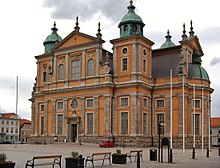Kalmar Cathedral (Swedish: Kalmar domkyrka) is in the city of Kalmar in Småland in southeast Sweden.[1] Located in Stortorget Square, construction began in 1660. The Cathedral was designed for the Church of Sweden by architect Nicodemus Tessin.[2]
| Kalmar Cathedral | |
|---|---|
| Kalmar domkyrka | |
 Kalmar Cathedral | |
 | |
| 56°39′52″N 16°21′55″E / 56.66444°N 16.36528°E | |
| Location | Kalmar |
| Country | Sweden |
| Denomination | Church of Sweden |
| History | |
| Status | Active |
| Consecrated | 1682 |
| Architecture | |
| Functional status | Cathedral & Parish church |
| Architect(s) | Nicodemus Tessin the Elder |
| Style | Baroque |
| Completed | 1703 |
| Administration | |
| Diocese | Växjö |
| Clergy | |
| Vicar(s) | Peter Wänehag |
| Dean | Christer Munther |
| Deacon(s) | Ingrid Svedjenäs |
| Laity | |
| Organist(s) | Jan Börjesson |
History
editThe new city of Kalmar was built on Kvarnholmen island in the mid-17th century. The transfer from the old town was largely completed by 1658. The new, fortified town was planned along Renaissance ideals. Accordingly, the church and town hall were constructed across from one another in the old town square (Stortorget Kalmar). The material in the masonry consists of limestone from Gotland. The vaults, portals and window coverings are made of brick. The roof was lined with copper plate. The cathedral was built without a dome and with high window openings.[3]
The cathedral was designed by Nicodemus Tessin the Elder (1615–1681) and is one of the foremost examples of classical baroque architecture that was a breakthrough in Sweden. The design of Kalmar Cathedral reflects the complexities of modernisation, maintaining liturgical utility and tradition, and being mindful of the fortress-city requirements. Construction began in 1660, but was interrupted on several occasions, including with the outbreak of the Scanian War (1675–1679). The work resumed after the war and Kalmar Cathedral was finally finished in 1703.[4]
Restorations
editOver the centuries, the church has been the subject of numerous restorations
In 1783, extensive external and internal restoration was initiated. In 1800, the city was hit by an extensive fire. In 1802 the damage was repaired. In 1831–1834, an external and internal restoration was carried out following a proposal by architect Jacob Wilhelm Gerss (1784-1844). The exterior restoration included both the church's exterior walls and the roof.[5]
In 1882–1883, a rebuilding of the interior was carried out following a drawing proposal by architect Helgo Zetterwall (1831-1907). During 1910–1914 years of restoration took place according to drawings and job descriptions by city architect Josef Fredrik Olson (1870-1947). The 1928-1932 restoration was also based on Fredrik Olson's proposal.[6][7]
Between 1981 and 1982, extensive restoration of the church's exterior was made. Between 2005 and 2011, restoration of the exterior took place, under the direction of Barup & Edström Arkitektkontor. Work included refurbishment of the church roof, stone restoration, facade staining. Internal restoration during 2006-2011 meant, among other things, raising and expanding the choir as well as new flooring.[8]
Gallery
edit-
Ornate pulpit
-
Pulpit sounding board or tester
-
Altar
-
Wall-mounted memorial
-
Baptismal font made by stonecutter Elving Nilsson
-
Organ
References
edit- ^ "Kalmar domkyrkoförsamling". svenskakyrkan.se. Retrieved 1 January 2020.
- ^ "Kalmar Domkyrka - Kalmar Cathedral". GuidebookSweden. Retrieved 31 October 2023.
- ^ "Kalmar Domkyrka". kalmar.com. Retrieved 1 January 2020.
- ^ "Kalmar Domkyrka". kalmar.com. Retrieved 1 January 2020.
- ^ "Gerss, Jacob Wilhelm (1784-1844)". KulturNav. Retrieved 1 January 2020.
- ^ "Helgo Zettervall". NE Nationalencyklopedin AB. Retrieved 1 January 2020.
- ^ "Olson, Fredrik (1870-1947)". KulturNav. Retrieved 1 January 2020.
- ^ "Kalmar domkyrka". barupedstrom.se. Retrieved 1 January 2020.
Related reading
edit- K. Neville (2009) Nicodemus Tessin the Elder. Architecture in Sweden in the Age of Greatness (Turnhout, Brepols Publishers) ISBN 978-2-503-52826-7